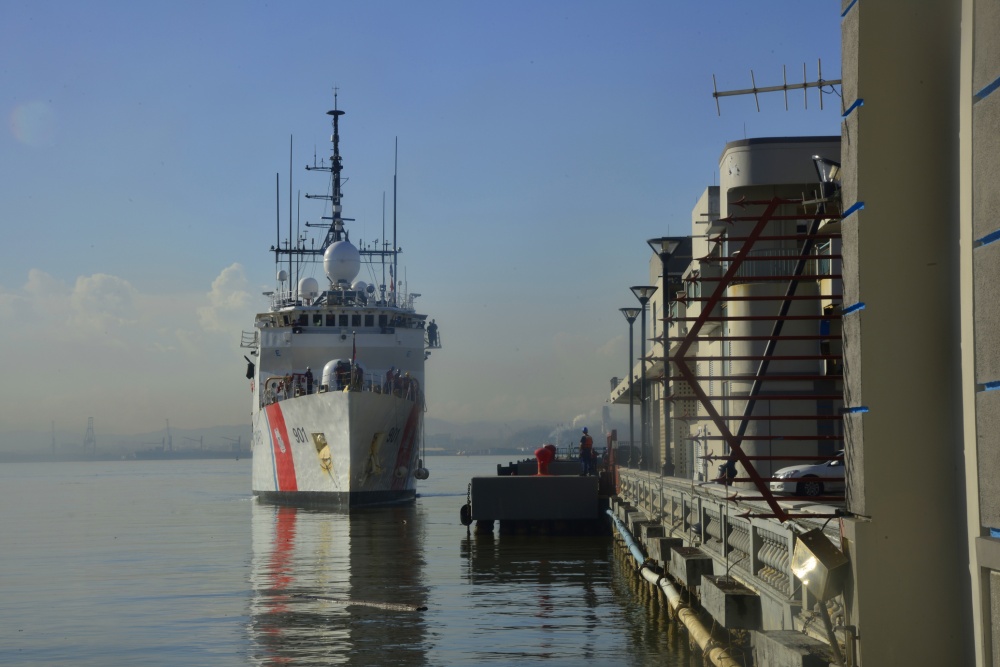
SAN DIEGO – Driven by greater demand for its partnerships and presence in the Indo-Pacific region, the U.S. Coast Guard is growing its operational presence in the vast region that’s unsettled by continuing incursions from China’s naval militia and fishing fleet, the Pacific Area commander told an audience today.
Part of that plan is the deployment of a 270-foot medium endurance cutter, based on the East Coast but undergoing a shipyard overhaul, to the Pacific sometime in 2024, Vice Adm. Andrew Tiongson, the Coast Guard Pacific Area Commander, said Wednesday during an address to the WEST conference, hosted by the U.S. Naval Institute and the Armed Forces Communications and Electronics Association.
“This cutter will remain in the Pacific and will build upon many decades of enduring presence, operating in concert with the needs of our allies and our partners,” said Tiongson, who also serves as the commander of Coast Guard Defense Force West, based in Alameda, Calif.
Tiongson, speaking with USNI News after his speech, declined to say which WMEC will make the home port change from Portsmouth, Va., after it completes a service life extension, but he added that some decisions are pending.
There are no medium-endurance cutters operating in the region, he noted. He envisions the medium-endurance cutter operating in the Pacific islands, much like the work of the now-retired USCGC Gentian, a buoy tender that spent its last decade as a support tender in the Caribbean. The tender went “from country to country, providing whatever that partner may need.” That might be law enforcement training or operations, he said. “If they want to do training on search and rescue, they’re equipped with that kind of thing,” Tiongson added.
“It’ll be persistently present in the region. That will be its mission,” he said.
Tiongson, noting the service’s long-running work with partners and other island nations in the region, said he wants its operations “to start it in the Blue Pacific, or Oceania, first.”
The WMEC deployment will mean a change of scenery for the cutter and its crew, at least for those who might make that homeport change. “They do a lot of East Africa [and] Caribbean” missions, he noted, “so I need to get them aligned with what’s going on in the blue Pacific.”
Some decisions remain. “Where it’s going to be homeported, we’re still working towards,” Tiongson said. “It’s going to be operating in ‘24.”
The service is considering rotating crews “to keep it there,” he said. “We don’t want it to be like that the whole time. But we need it to get the homeport thing figured out first. And it can be anywhere from Sasebo [Japan] to Honolulu.”
One thing’s for sure: The cutter will be busy. “We can expect to be 185 days away from home port,” he added.
An advantage of placing a medium-endurance cutter in that region “is we can bring other capabilities to bear, and that’s what we’ll focus mainly on,” Tiongson said, noting the Coast Guard’s authorities provided under the Department of Homeland Security differ from somewhat more restrictive ones under the Department of Defense.
“We’re not off doing our own thing. This is all integrated” with the Japan-based U.S. 7th Fleet, U.S. Pacific Fleet and U.S. Indo-Pacific Command. “And Adm. [John] Aquilino looks at me as one of his components,” he said.
“If we can capitalize and synchronize, then we’re doing the right thing,” Tiongson added.
The cutter will operate with law enforcement teams and have some medical capabilities, and there’s potential to further expand that where needed. “The demand signal is coming from the partners, and folks just trying to find innovative ways to get after it,” he said.
While new offshore patrol cutters are under construction, the medium cutters going through service life extensions will give the Coast Guard some robust capabilities into the near future. “Let’s start [with] where we understand, where I like to say we are habitually aligned. We have to get the crew aligned, or part of the crew that won’t rotate and will stay,” Tiongson said. “We’ll tip our foot in the water and see where we’re at. There’s a demand signal everywhere for this. But I want to take it, as I say, with a relentless incrementalism approach.”
“It’s going to be great. I’m excited about it,” he added.
The homeport change is one part of the Coast Guard’s growing initiatives in the Indo-Pacific, where the military has been expanding its roles and presence. “The Coast Guard is not conducting any new mission. We’re simply doing more of them in the region,” Tiongson told the WEST audience, “and seeking to complete our missions in new and better ways.”
The Coast Guard is the smallest of the services, a size akin to the New York City Police Department. “So it’s a big deal for us when we move people and hardware around the world,” he said.
“This year, we have tripled the number of national security cutters [sic] deployments into the western Pacific,” he said.
After last year’s single deployment of an NSC to the region, this year, the Coast Guard is sending three national security cutters to the Indo-Pacific. Hawaii-based cutter USCGC Kimball (WMSL-756) is currently deployed and operating in U.S. 7th Fleet “with the Japan coast guard,” he said. Two more national security cutters are scheduled to deploy to the region this year.
“We’ve expanded the reach of our smaller cutters, like the fast response cutters, across the blue Pacific, with effective expeditionary logistics and creative force packaging,” Tiongson said. One of the FRCs – Guam-based USCGC Oliver Henry (WPC-1140) – last year deployed to Cairns, Australia as part of an extended Micronesia patrol, working with partner coastal forces and assisting with fisheries enforcement.





